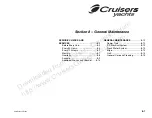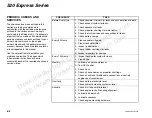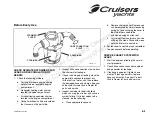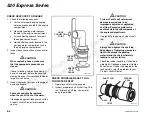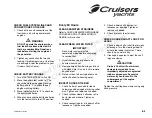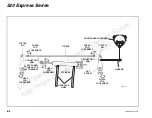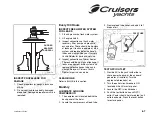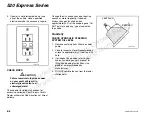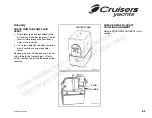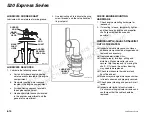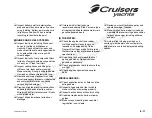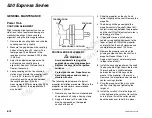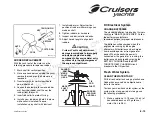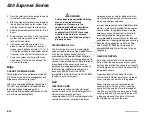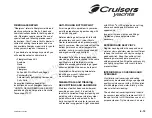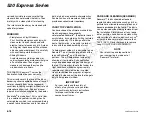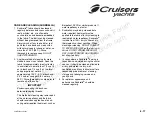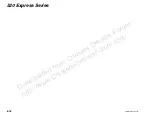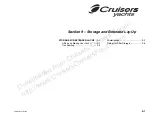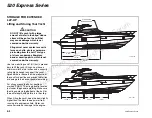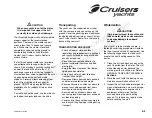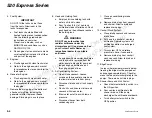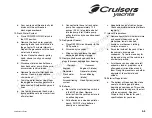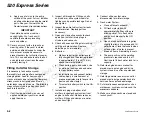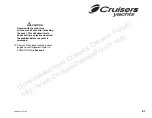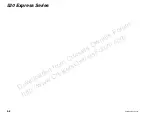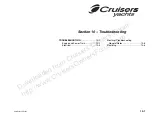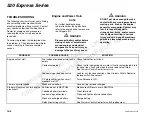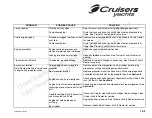
8-14
520 Express Series
520 Express Series
2. Pour the solution into the empty tank and
fill the tank with fresh water.
3. Start the fresh water pump and bleed all
the air from the fresh water system. Start
with the faucet farthest from the pump.
4. Allow the treated water to stand for 3 to 4
hours.
5. Drain the tank and lines. Flush the entire
system with clean fresh water. Fill the
tank with fresh water.
6. If an excessive chlorine taste is still
present, make a solution of 1 quart of
vinegar and 5 gallons of water (1 L to 19
L). Add the solution to the system and let
it remain in the system for several days.
7. Drain the system and flush with clean
fresh water. Fill the tank and bleed the
air from all the lines.
Bilge
CLEAN THE BILGE AREA
Pump bilge area dry and remove all loose
dirt. Make sure all drain passageways and
bilge pump strainers are clear.
After time, the bilge will collect dirt and oil.
DO NOT use flammable solvents to clean
the bilge. Frequent cleaning with a
commercial bilge cleaner will loosen oil and
dirt and make cleaning easy.
DANGER
Fumes from rags can collect in bilge
area and can be extremely
dangerous. If cleanup is in a
confined area without ventilation,
wear a suitable mask to avoid
asphyxiation. DO NOT store rags
used to wipe up fuel or solvent
spills in the yacht. Dispose of rags
properly ashore.
DISCHARGE OF OIL
The discharge of oil or oily waste into or
upon navigable waters of the United States
or of the contiguous zones is strictly
prohibited by the Federal Water Pollution
Control Act. If such a discharge occurs and
causes a film or sheen on or discoloration of
the surface of the water, or causes an
emulsion or sludge beneath the surface of
the water, the violators are subject to a
penalty of $5,000. Notify the USCG
immediately or call toll-free 1-800-424-8802
to report any such incident.
Hull
GELCOAT CARE
A complete washdown of all exterior gel
coated surfaces with a mild detergent and
clean water after each outing is
recommended. DO NOT use detergents that
contain ammonia or chlorine. Alcohol or
kerosene may be used for stubborn stains.
Light sanding and buffing will remove most
stains and shallow scratches.
In areas where your yacht is stored for winter
months, a pre-launch waxing for the season
should suffice. In southern areas, wax the
exterior surfaces at least semi-annually. A
specially formulated fiberglass wax is
recommended to prevent any color fade and
soil adhesion. If waxing alone does not bring
back the shiny appearance, hand buffing
with DuPont #7 Rubbing Compound or
power buffing with Mirror Glaze #1 may be
necessary.
GELCOAT REPAIR
Scratches or blemishes in the gelcoat may
detract from the appearance of your yacht,
but they do not affect the strength or integrity
of the fiberglass hull or the component which
the gelcoat covers.
A gelcoat repair kit, available from your
Cruiser Yachts Dealer permits you to repair
minor scratches and nicks in the gelcoat.
Minor scratches can be removed by wet
sanding. Start with 320 grit first, sanding
lightly until the scratch starts to disappear.
Use 400 grit until the scratch is gone. Finish
sanding with 600 grit and buff the area with
rubbing compound. Rub hard at first and
then lighten up to polish the area.
Downloaded
from
Cruisers
Owners
Forum
http://www.CruisersOwnersForum.com


